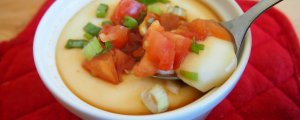
English bloomer
(785838 views)
It's a basic British bread. You can change your tastes after learning it. It's picked from BBC website. It's tried and tried. It's become the main product of homeau bread.
Cooking ingredients
Cooking Steps

Step1:Yeast dissolved in 240ml ~ (not all of them.) yes. Cold water ~ this makes bread taste better [see Tips

Step2:Mix the salt and flour. Then pile them into a pile of flour. Dig holes in the middle. Pour in the yeast solution and olive oil. Slowly mix the water powder. Gradually add the remaining 80ml of water. As the case may be. Maybe it can't be used up. In short, until all the flour is stained, it will form a soft and rough doug

Step3:Apply a thin layer of oil on the clean operation platform to prevent sticking, and then start to knead the dough until it is smooth, elastic and soft (no need to leave the film). Please turn the TX of the soft and drawable bread to the right and find another recipe. Then put it into a clean, oiled pot. Cover with plastic wrap. Place in a warm place. Start the first fermentation. Ferment to 22.5 times the siz

Step4:The method to check whether the fermentation is completed - dip your finger in flour and poke it into the dough. If it can form the same nest as shown in the figure and does not rebound, then the fermentation is in place. If it rebounds, it will not ferment enough; if it pokes a hole, the whole dough will stay. It proves that the fermentation is excessiv

Step5:Pour out the dough. Pull it apart by hand. Form a rectangle

Step6:Finger joint press. Exhaus

Step7:Roll it up from top to bottom. Pay attention to each roll according to the actual situation. Close it from both sides to the middl

Step8:Like thi

Step9:After rolling, close the mouth down. Pay attention to the bonding

Step10:(I made 750g of flour and divided it into three parts) after rolling, put it in the baking tray covered with baking paper, cover with plastic film, place it in a warm place for secondary fermentation, reaching 1.52 times the size

Step11:After fermentatio

Step12:Spray water. Sprinkle flour. Cut the ba

Step13:Preheat the oven to 220 degrees. When preheat, put an empty baking tray on the bottom. When the dough is put into the oven (the bread is placed on the upper layer of the empty baking tray), spray water to make steam. Then pour cold water (make steam) into the empty baking tray quickly. Quickly close the oven door. 220 ℃ for 25 minutes. Lower to 200 ℃ and bake for 10 minutes.

Step14:After baking, move it to the net rack to cool it and then cut it. During the cooling process, the bread can really sing
Cooking tips:1. The purpose of pouring cold water into the preheated iron plate in the oven is to make water vapor and quickly form a crispy shell on the surface of the bread. Before putting the dough into the oven, I spray water to make steam. 2.320ml of water may not be used up completely. The water absorption of flour is different. Please increase or decrease as the case may be. 3. Olive oil is added because it can prolong the storage time of bread. 4. Many people are used to adding warm water when making bread It's wrong to use cold water to make yeast grow slowly and make bread with better flavor. There are skills in making delicious dishes.
 Chinese Food
Chinese Food












